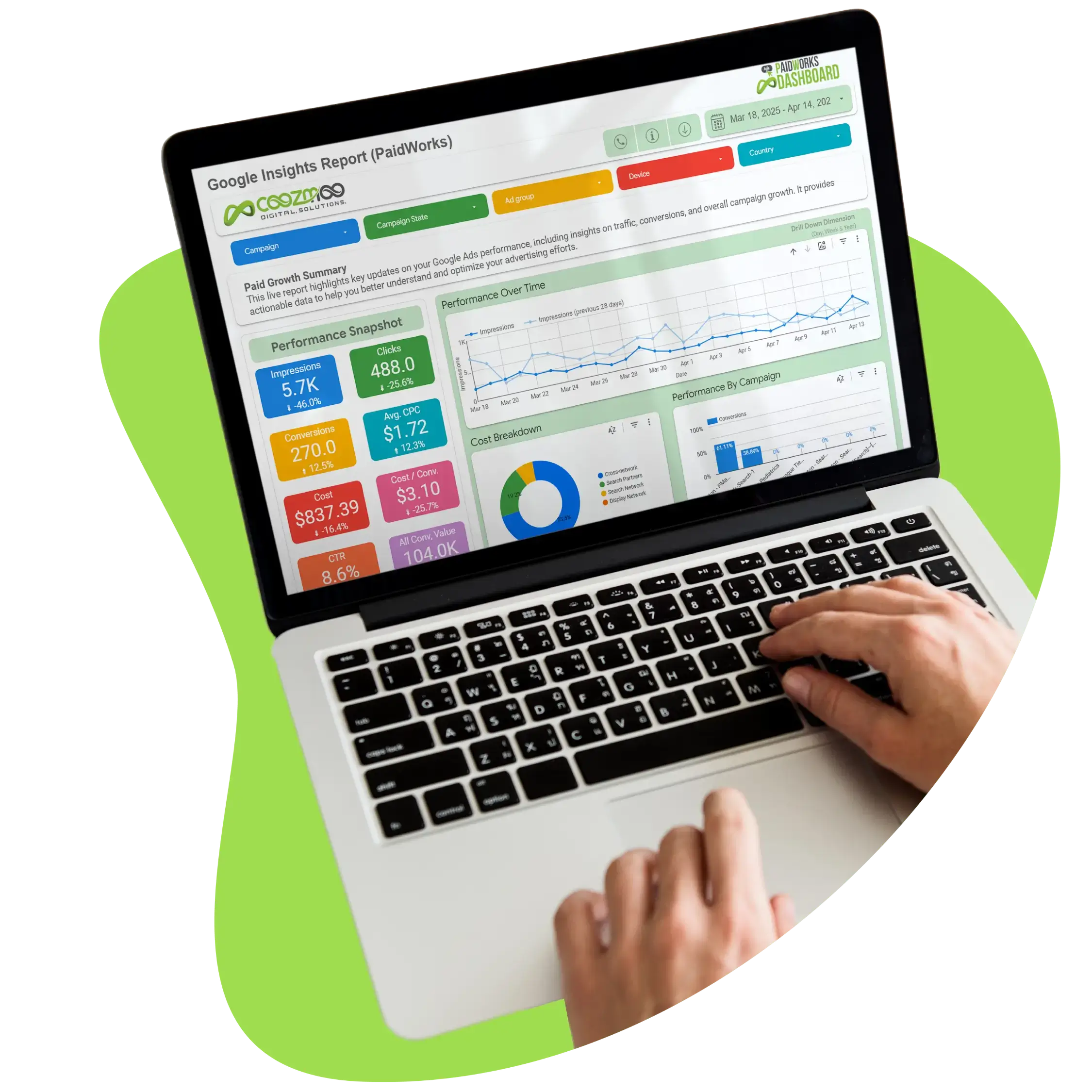Google Ads vs. Meta Ads in 2025: Stats, Trends & What Marketers Need to Know?
Google Ads vs. Meta Ads in 2025: Stats, Trends & What Marketers Need to Know?
Google Ads vs. Meta Ads in 2025: Stats, Trends & What Marketers Need to Know?
Table of Content
Title
Title
Explore Free Tools








Richa Dave
Richa Dave
Richa Dave
Richa Dave
Richa Dave
PPC
PPC
PPC
PPC
PPC
10 Min Read
10 Min Read
10 Min Read
10 Min
10 Min
Oct 16, 2025
Oct 16, 2025
Oct 16, 2025
10/16/25
10/16/25
The digital advertising landscape is defined by two giants: Google Ads and Meta Ads (Facebook, Instagram, WhatsApp). In 2025, these platforms dominate ad budgets, business strategies, and consumer attention.
In this blog, we’ll look at the most recent statistics and trends from both – Google and Meta ads, giving marketers and decision-makers the information they need to improve campaigns and get the most out of their investments.
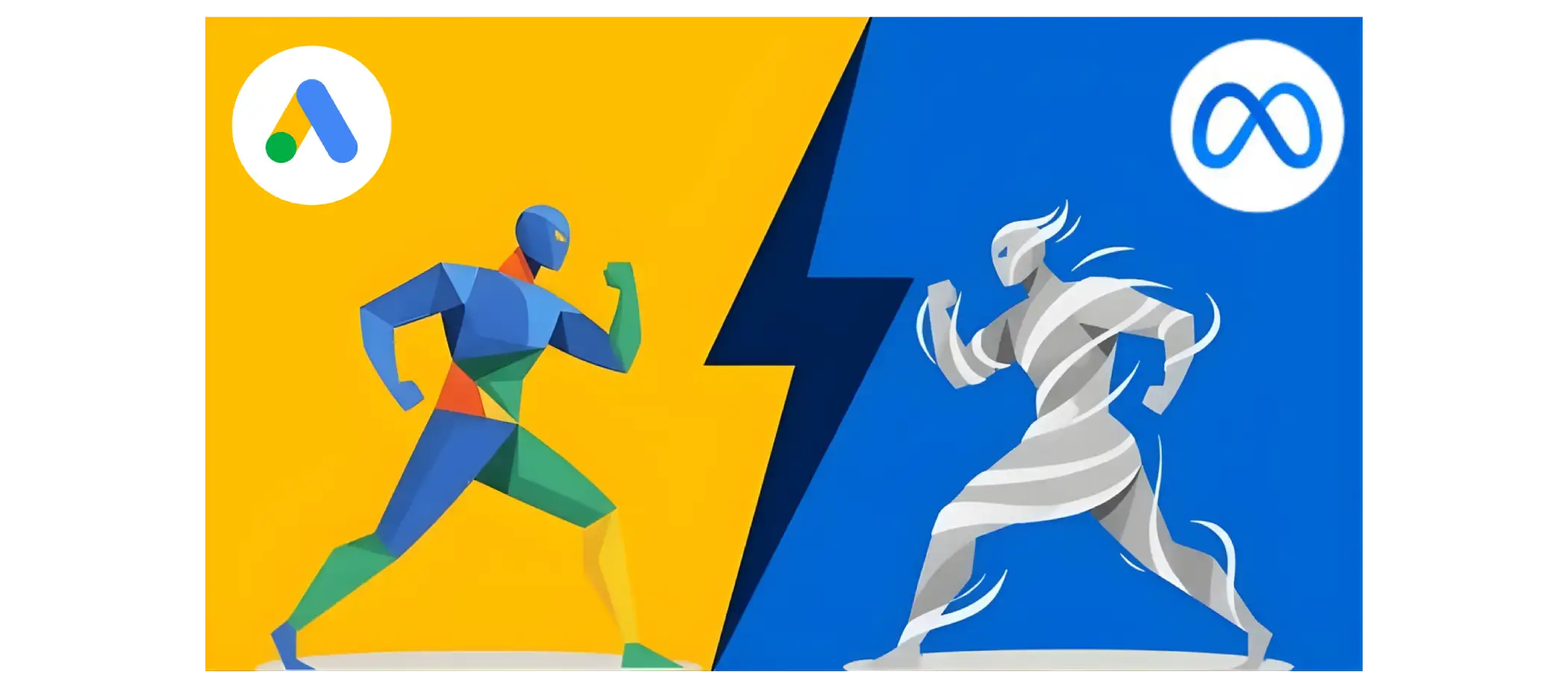
Google Ads: The Search Engine Giant
1. In 2023, Google made $237.8 billion from ads, which was more than 77% of its entire revenue. By 2027, experts say that Google's ad revenue will reach $340 billion, maintaining its rapid expansion.

2. In 2023, Google controlled 39% of all digital ad spending throughout the world, more than twice as much as Meta's 18%. This made Google the best site to advertise in the world.
3. Share of the Search Ad Market
In 2024, Google's search ad income in the US was projected to reach $62.87 billion, which is a tremendous amount more than Microsoft and all its competitors.
It has a 90.01% share of the global search market, with more than 94% of searches done on mobile devices and more than 2 million websites in its Display Network.
Source : EMarketer

4. Cost and Value of Ads
The average cost per click (CPC) went up to $4.66 in 2024 because of more competition and inflation.
The cost per lead (CPL) went up to $66.69, and more than 80% of industries saw year-on-year increases. This was especially true in high-value segments like legal services, where single keywords can cost more than $200.
Even while expenses are going up, ROI is still quite high: every $1 invested brings $2 in direct return, or up to $8 if you count the extra organic search benefits. This shows how well-paid and organic tactics work together.
Source : Digital Information World
5. Metrics for Performance
Google Ads is used by 98% of PPC experts, and 80% to 85% of PPC funds go to it. This shows how important it is in performance marketing.
The average clickthrough rate (CTR) in 2024 was 6.42%, which was a small increase from 2023. The average conversion rate was 6.96%. Some industries, including automotive and healthcare, have conversion rates of more than 12%. Others, like finance and furniture, have rates as low as 2.5%.
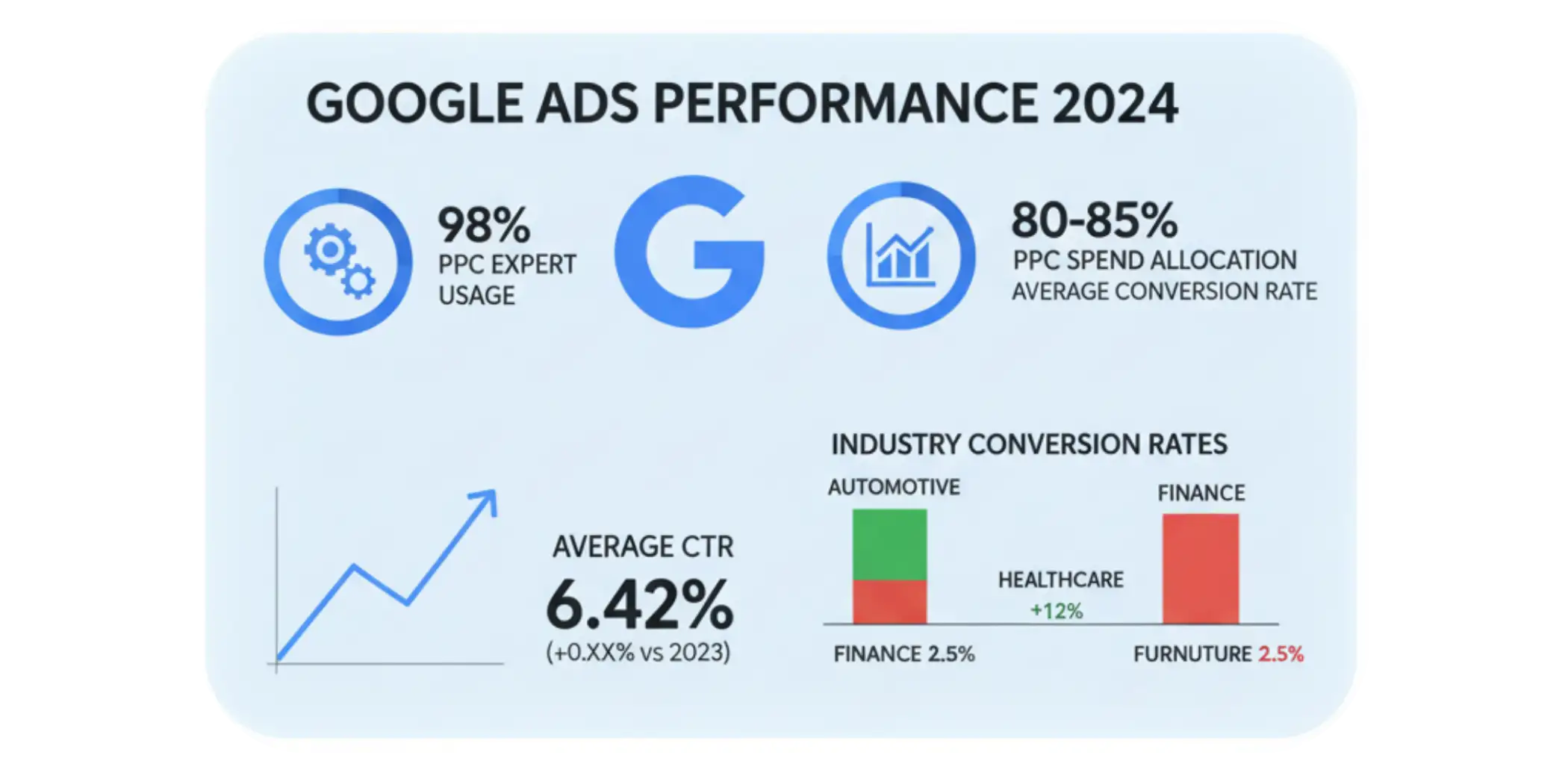
6. Ads for mobile devices and shopping
Mobile is what makes Google strong, 73% of clicks on US search ads originate from mobile devices.
Google Shopping gets more than a third of all sponsored clicks in online stores, and 71% of US consumers who know about Google Shopping give the brand a good grade.
7. Insights into User Behavior
Long-tail keywords are used in an amazing 91.8% of Google searches. This means that advertisers can target specific groups of people and pay less per click in well-optimized campaigns.
Google is still the most important part of the buying process in the US, even if 50% of online purchases start on Amazon.
Meta Ads: The Social Advertising Powerhouse
1 . Sales and Market Reach
Meta made 18% of all digital ad money in 2023, second only to Google. In 2023, Facebook's ad income alone was over $152 billion worldwide.
By 2025, Meta's entire ecosystem, which includes Instagram and WhatsApp, is estimated to be worth more than $170 billion.
2. Massive Audience Size
There are almost 8 million advertisers on all of Meta's sites, making Facebook Ads and Instagram Ads two of the most popular ways to market things in the world.
Meta's platforms together reach over 3.9 billion active users every month, which greatly increases advertisers' ability to reach and segment their target audiences.


3. Performance and cost-effectiveness
The average cost per click (CPC) for Meta traffic campaigns is about $0.77, and for lead generation advertising, it's $1.88. This is a lot less than Google advertising.
Depending on the ad format and targeting, CPM (cost per thousand impressions) usually falls between $4 and $10.
Click through rates (CTR) are strong, averaging 2.53% across lead-gen campaigns and often higher in fields like arts, entertainment, and real estate. Retargeting advertising often do better than prospecting ads.
4. Power of Conversion and ROI
In 2024-25, the average conversion rate for Facebook advertising is roughly 8.78%. Some industries have rates higher than 10%.
Meta Ads can provide you a return of $6 for every $1 spent on e-commerce (6:1 ROAS). Some campaigns that are optimized for purchases can even do better.
93% of social media marketers use Facebook Ads to reach out to customers and use Meta's targeting to nurture leads at every level of the funnel.

5. Industry Variations and Trends
Meta Ads work well for businesses that rely on stories and pictures, like retail, travel, entertainment, and D2C brands, which have high CTR and engagement.
Lead generation and remarketing have a quick return on investment (ROI), but B2B or highly regulated industries may have longer customer journeys and lower conversion rates.
6. The Evolution of Algorithms and Optimization
Meta's AI-driven optimizations, such as Advantage+ Placements and broad targeting, have raised CTR and conversion rates while keeping costs low, especially when budgets are adjusted and campaigns don't set their audiences too narrowly.
Testing single-creative ad sets, optimizing for purchases, and using bespoke audiences to get better ROAS are all best practices.
Strategic Insights for Advertisers
Budget Allocation: Most companies spend most of their money on paid search and intent marketing on Google. They use Meta for upper-funnel awareness, lead generation, and retargeting, especially if they are targeting younger people or are visually driven.
Ad Goals: Google is great at getting people who are actively looking to buy, while Meta uses social, visual, and story-driven ad formats to engage, nurture, and retarget audiences.
Industry Fit: Google gives you the fastest ROI on high-ticket, urgent-need services like legal, real estate, finance, and healthcare. Meta's storytelling and branding reach is most helpful for fashion, lifestyle, entertainment, and direct-to-consumer businesses.
Mobile First: Both networks are focused on mobile devices, with more than 70% of ad actions happening on smartphones and tablets. This means that creative and landing pages need to be optimized for mobile devices.
Tactics for optimization: AI-powered optimization, targeting a wide audience, and retargeting across channels are still very important for the success of a campaign.
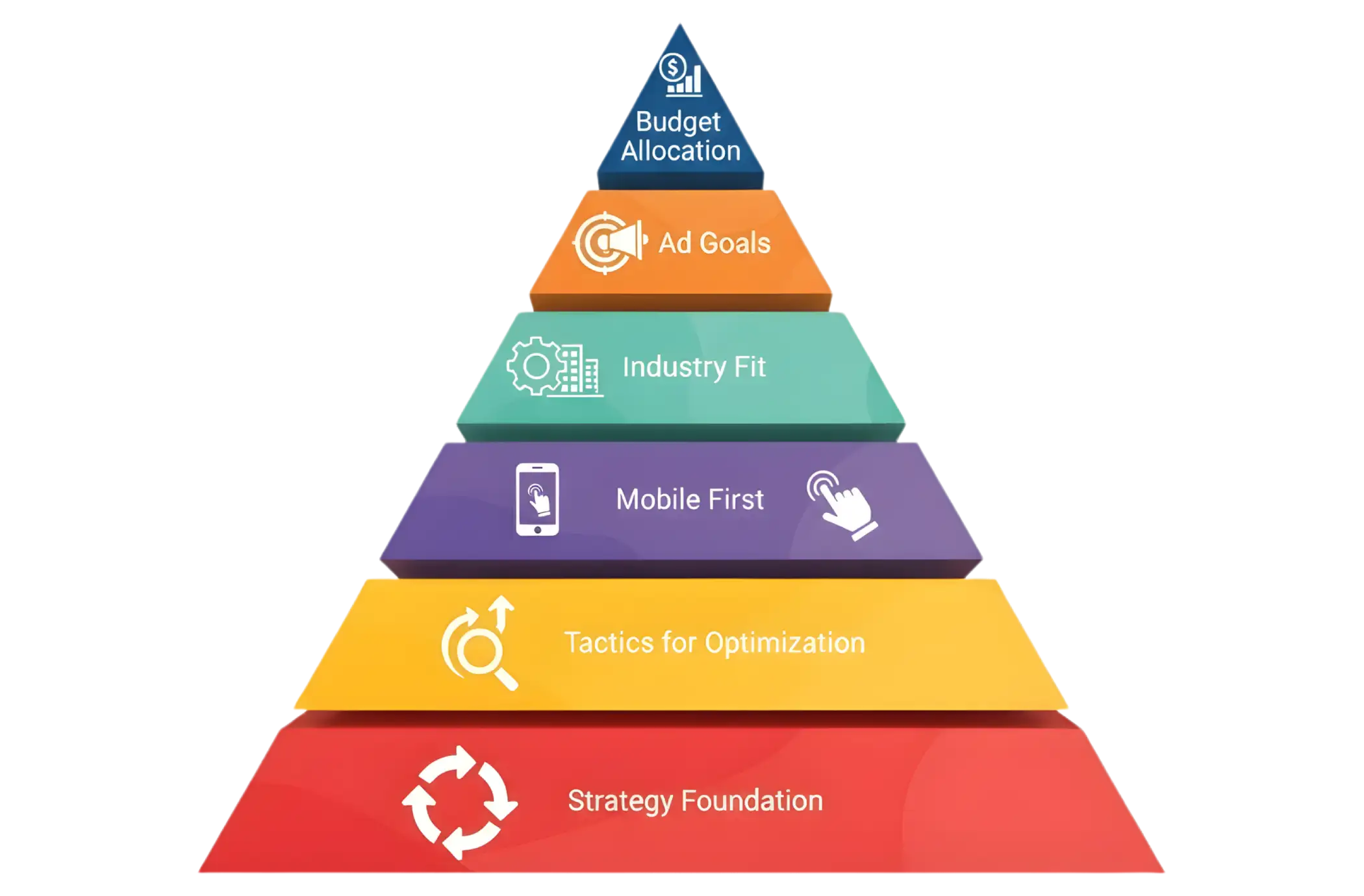
Final Thoughts
In 2025, Google Ads and Meta Ads have continued to evolve, shaping the way businesses reach and engage their audiences. Google Ads is still the best way to get high-intent traffic and conversions that can be measured. Meta Ads, on the other hand, are great for raising brand awareness, getting people involved in the community, and reaching people on a variety of social media platforms, like Facebook, Instagram, WhatsApp, and Threads.
The secret to getting the most out of your investment for businesses is not to pick one platform over the other, but to combine them in a smart way. Google Ads may reach people right when they are looking for your goods or services, whereas Meta Ads can keep those leads engaged in interesting content, remarketing campaigns, and immersive experiences.
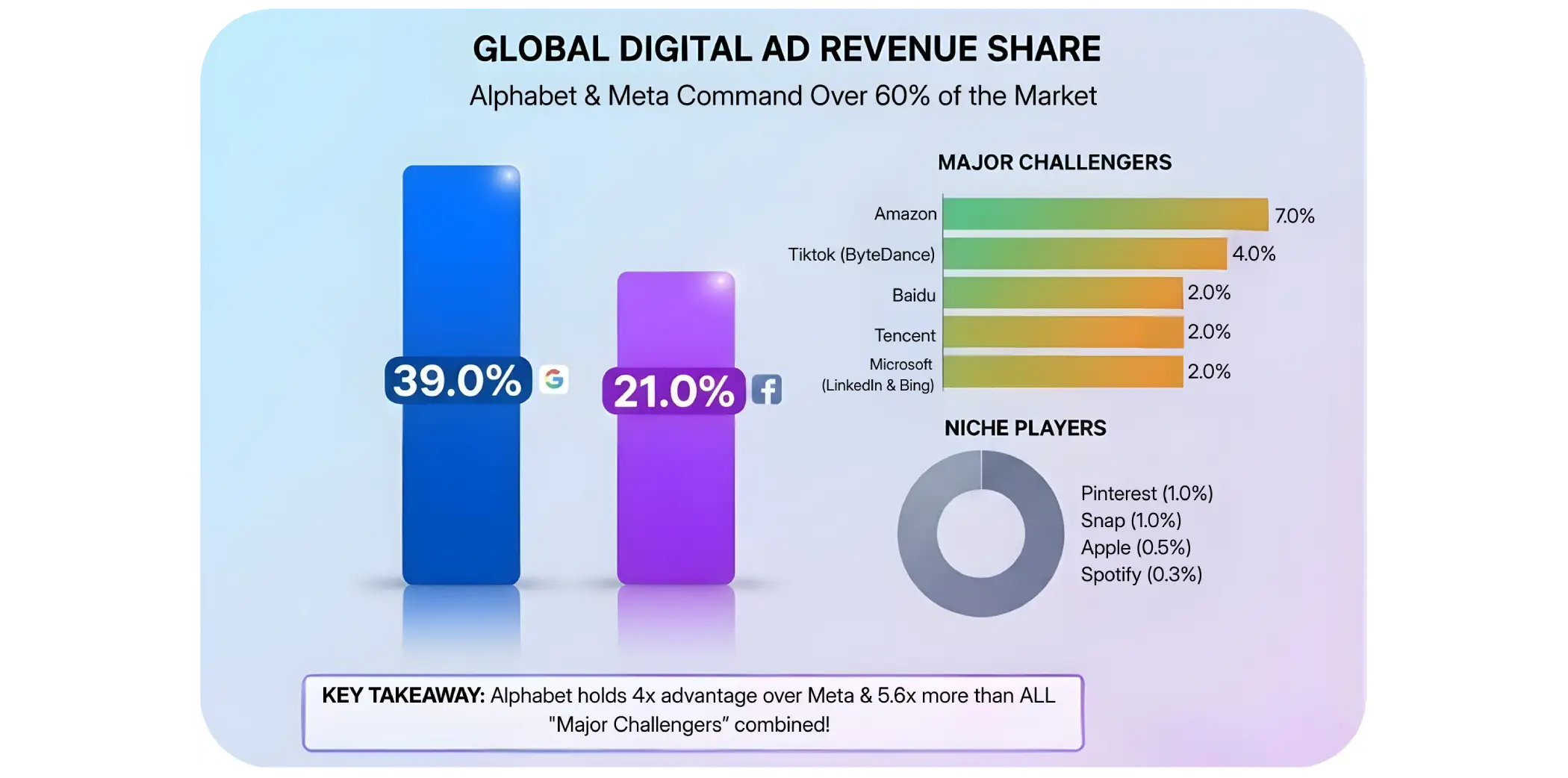
The digital advertising landscape is defined by two giants: Google Ads and Meta Ads (Facebook, Instagram, WhatsApp). In 2025, these platforms dominate ad budgets, business strategies, and consumer attention.
In this blog, we’ll look at the most recent statistics and trends from both – Google and Meta ads, giving marketers and decision-makers the information they need to improve campaigns and get the most out of their investments.

Google Ads: The Search Engine Giant
1. In 2023, Google made $237.8 billion from ads, which was more than 77% of its entire revenue. By 2027, experts say that Google's ad revenue will reach $340 billion, maintaining its rapid expansion.

2. In 2023, Google controlled 39% of all digital ad spending throughout the world, more than twice as much as Meta's 18%. This made Google the best site to advertise in the world.
3. Share of the Search Ad Market
In 2024, Google's search ad income in the US was projected to reach $62.87 billion, which is a tremendous amount more than Microsoft and all its competitors.
It has a 90.01% share of the global search market, with more than 94% of searches done on mobile devices and more than 2 million websites in its Display Network.
Source : EMarketer

4. Cost and Value of Ads
The average cost per click (CPC) went up to $4.66 in 2024 because of more competition and inflation.
The cost per lead (CPL) went up to $66.69, and more than 80% of industries saw year-on-year increases. This was especially true in high-value segments like legal services, where single keywords can cost more than $200.
Even while expenses are going up, ROI is still quite high: every $1 invested brings $2 in direct return, or up to $8 if you count the extra organic search benefits. This shows how well-paid and organic tactics work together.
Source : Digital Information World
5. Metrics for Performance
Google Ads is used by 98% of PPC experts, and 80% to 85% of PPC funds go to it. This shows how important it is in performance marketing.
The average clickthrough rate (CTR) in 2024 was 6.42%, which was a small increase from 2023. The average conversion rate was 6.96%. Some industries, including automotive and healthcare, have conversion rates of more than 12%. Others, like finance and furniture, have rates as low as 2.5%.

6. Ads for mobile devices and shopping
Mobile is what makes Google strong, 73% of clicks on US search ads originate from mobile devices.
Google Shopping gets more than a third of all sponsored clicks in online stores, and 71% of US consumers who know about Google Shopping give the brand a good grade.
7. Insights into User Behavior
Long-tail keywords are used in an amazing 91.8% of Google searches. This means that advertisers can target specific groups of people and pay less per click in well-optimized campaigns.
Google is still the most important part of the buying process in the US, even if 50% of online purchases start on Amazon.
Meta Ads: The Social Advertising Powerhouse
1 . Sales and Market Reach
Meta made 18% of all digital ad money in 2023, second only to Google. In 2023, Facebook's ad income alone was over $152 billion worldwide.
By 2025, Meta's entire ecosystem, which includes Instagram and WhatsApp, is estimated to be worth more than $170 billion.
2. Massive Audience Size
There are almost 8 million advertisers on all of Meta's sites, making Facebook Ads and Instagram Ads two of the most popular ways to market things in the world.
Meta's platforms together reach over 3.9 billion active users every month, which greatly increases advertisers' ability to reach and segment their target audiences.


3. Performance and cost-effectiveness
The average cost per click (CPC) for Meta traffic campaigns is about $0.77, and for lead generation advertising, it's $1.88. This is a lot less than Google advertising.
Depending on the ad format and targeting, CPM (cost per thousand impressions) usually falls between $4 and $10.
Click through rates (CTR) are strong, averaging 2.53% across lead-gen campaigns and often higher in fields like arts, entertainment, and real estate. Retargeting advertising often do better than prospecting ads.
4. Power of Conversion and ROI
In 2024-25, the average conversion rate for Facebook advertising is roughly 8.78%. Some industries have rates higher than 10%.
Meta Ads can provide you a return of $6 for every $1 spent on e-commerce (6:1 ROAS). Some campaigns that are optimized for purchases can even do better.
93% of social media marketers use Facebook Ads to reach out to customers and use Meta's targeting to nurture leads at every level of the funnel.

5. Industry Variations and Trends
Meta Ads work well for businesses that rely on stories and pictures, like retail, travel, entertainment, and D2C brands, which have high CTR and engagement.
Lead generation and remarketing have a quick return on investment (ROI), but B2B or highly regulated industries may have longer customer journeys and lower conversion rates.
6. The Evolution of Algorithms and Optimization
Meta's AI-driven optimizations, such as Advantage+ Placements and broad targeting, have raised CTR and conversion rates while keeping costs low, especially when budgets are adjusted and campaigns don't set their audiences too narrowly.
Testing single-creative ad sets, optimizing for purchases, and using bespoke audiences to get better ROAS are all best practices.
Strategic Insights for Advertisers
Budget Allocation: Most companies spend most of their money on paid search and intent marketing on Google. They use Meta for upper-funnel awareness, lead generation, and retargeting, especially if they are targeting younger people or are visually driven.
Ad Goals: Google is great at getting people who are actively looking to buy, while Meta uses social, visual, and story-driven ad formats to engage, nurture, and retarget audiences.
Industry Fit: Google gives you the fastest ROI on high-ticket, urgent-need services like legal, real estate, finance, and healthcare. Meta's storytelling and branding reach is most helpful for fashion, lifestyle, entertainment, and direct-to-consumer businesses.
Mobile First: Both networks are focused on mobile devices, with more than 70% of ad actions happening on smartphones and tablets. This means that creative and landing pages need to be optimized for mobile devices.
Tactics for optimization: AI-powered optimization, targeting a wide audience, and retargeting across channels are still very important for the success of a campaign.

Final Thoughts
In 2025, Google Ads and Meta Ads have continued to evolve, shaping the way businesses reach and engage their audiences. Google Ads is still the best way to get high-intent traffic and conversions that can be measured. Meta Ads, on the other hand, are great for raising brand awareness, getting people involved in the community, and reaching people on a variety of social media platforms, like Facebook, Instagram, WhatsApp, and Threads.
The secret to getting the most out of your investment for businesses is not to pick one platform over the other, but to combine them in a smart way. Google Ads may reach people right when they are looking for your goods or services, whereas Meta Ads can keep those leads engaged in interesting content, remarketing campaigns, and immersive experiences.

The digital advertising landscape is defined by two giants: Google Ads and Meta Ads (Facebook, Instagram, WhatsApp). In 2025, these platforms dominate ad budgets, business strategies, and consumer attention.
In this blog, we’ll look at the most recent statistics and trends from both – Google and Meta ads, giving marketers and decision-makers the information they need to improve campaigns and get the most out of their investments.

Google Ads: The Search Engine Giant
1. In 2023, Google made $237.8 billion from ads, which was more than 77% of its entire revenue. By 2027, experts say that Google's ad revenue will reach $340 billion, maintaining its rapid expansion.

2. In 2023, Google controlled 39% of all digital ad spending throughout the world, more than twice as much as Meta's 18%. This made Google the best site to advertise in the world.
3. Share of the Search Ad Market
In 2024, Google's search ad income in the US was projected to reach $62.87 billion, which is a tremendous amount more than Microsoft and all its competitors.
It has a 90.01% share of the global search market, with more than 94% of searches done on mobile devices and more than 2 million websites in its Display Network.
Source : EMarketer

4. Cost and Value of Ads
The average cost per click (CPC) went up to $4.66 in 2024 because of more competition and inflation.
The cost per lead (CPL) went up to $66.69, and more than 80% of industries saw year-on-year increases. This was especially true in high-value segments like legal services, where single keywords can cost more than $200.
Even while expenses are going up, ROI is still quite high: every $1 invested brings $2 in direct return, or up to $8 if you count the extra organic search benefits. This shows how well-paid and organic tactics work together.
Source : Digital Information World
5. Metrics for Performance
Google Ads is used by 98% of PPC experts, and 80% to 85% of PPC funds go to it. This shows how important it is in performance marketing.
The average clickthrough rate (CTR) in 2024 was 6.42%, which was a small increase from 2023. The average conversion rate was 6.96%. Some industries, including automotive and healthcare, have conversion rates of more than 12%. Others, like finance and furniture, have rates as low as 2.5%.

6. Ads for mobile devices and shopping
Mobile is what makes Google strong, 73% of clicks on US search ads originate from mobile devices.
Google Shopping gets more than a third of all sponsored clicks in online stores, and 71% of US consumers who know about Google Shopping give the brand a good grade.
7. Insights into User Behavior
Long-tail keywords are used in an amazing 91.8% of Google searches. This means that advertisers can target specific groups of people and pay less per click in well-optimized campaigns.
Google is still the most important part of the buying process in the US, even if 50% of online purchases start on Amazon.
Meta Ads: The Social Advertising Powerhouse
1 . Sales and Market Reach
Meta made 18% of all digital ad money in 2023, second only to Google. In 2023, Facebook's ad income alone was over $152 billion worldwide.
By 2025, Meta's entire ecosystem, which includes Instagram and WhatsApp, is estimated to be worth more than $170 billion.
2. Massive Audience Size
There are almost 8 million advertisers on all of Meta's sites, making Facebook Ads and Instagram Ads two of the most popular ways to market things in the world.
Meta's platforms together reach over 3.9 billion active users every month, which greatly increases advertisers' ability to reach and segment their target audiences.


3. Performance and cost-effectiveness
The average cost per click (CPC) for Meta traffic campaigns is about $0.77, and for lead generation advertising, it's $1.88. This is a lot less than Google advertising.
Depending on the ad format and targeting, CPM (cost per thousand impressions) usually falls between $4 and $10.
Click through rates (CTR) are strong, averaging 2.53% across lead-gen campaigns and often higher in fields like arts, entertainment, and real estate. Retargeting advertising often do better than prospecting ads.
4. Power of Conversion and ROI
In 2024-25, the average conversion rate for Facebook advertising is roughly 8.78%. Some industries have rates higher than 10%.
Meta Ads can provide you a return of $6 for every $1 spent on e-commerce (6:1 ROAS). Some campaigns that are optimized for purchases can even do better.
93% of social media marketers use Facebook Ads to reach out to customers and use Meta's targeting to nurture leads at every level of the funnel.

5. Industry Variations and Trends
Meta Ads work well for businesses that rely on stories and pictures, like retail, travel, entertainment, and D2C brands, which have high CTR and engagement.
Lead generation and remarketing have a quick return on investment (ROI), but B2B or highly regulated industries may have longer customer journeys and lower conversion rates.
6. The Evolution of Algorithms and Optimization
Meta's AI-driven optimizations, such as Advantage+ Placements and broad targeting, have raised CTR and conversion rates while keeping costs low, especially when budgets are adjusted and campaigns don't set their audiences too narrowly.
Testing single-creative ad sets, optimizing for purchases, and using bespoke audiences to get better ROAS are all best practices.
Strategic Insights for Advertisers
Budget Allocation: Most companies spend most of their money on paid search and intent marketing on Google. They use Meta for upper-funnel awareness, lead generation, and retargeting, especially if they are targeting younger people or are visually driven.
Ad Goals: Google is great at getting people who are actively looking to buy, while Meta uses social, visual, and story-driven ad formats to engage, nurture, and retarget audiences.
Industry Fit: Google gives you the fastest ROI on high-ticket, urgent-need services like legal, real estate, finance, and healthcare. Meta's storytelling and branding reach is most helpful for fashion, lifestyle, entertainment, and direct-to-consumer businesses.
Mobile First: Both networks are focused on mobile devices, with more than 70% of ad actions happening on smartphones and tablets. This means that creative and landing pages need to be optimized for mobile devices.
Tactics for optimization: AI-powered optimization, targeting a wide audience, and retargeting across channels are still very important for the success of a campaign.

Final Thoughts
In 2025, Google Ads and Meta Ads have continued to evolve, shaping the way businesses reach and engage their audiences. Google Ads is still the best way to get high-intent traffic and conversions that can be measured. Meta Ads, on the other hand, are great for raising brand awareness, getting people involved in the community, and reaching people on a variety of social media platforms, like Facebook, Instagram, WhatsApp, and Threads.
The secret to getting the most out of your investment for businesses is not to pick one platform over the other, but to combine them in a smart way. Google Ads may reach people right when they are looking for your goods or services, whereas Meta Ads can keep those leads engaged in interesting content, remarketing campaigns, and immersive experiences.


Have a Google Ads account?
Get a free audit Today!
Have a Google Ads account?
Get a free audit Today!


4.9/5 Ratings!


4.9/5 Ratings!


Don’t miss our revenue growth tips!
Get expert marketing tips—straight to your inbox, like thousands of happy clients.


Don’t miss our revenue growth tips!
Get expert marketing tips—straight to your inbox, like thousands of happy clients.


Don’t miss our revenue growth tips!
Get expert marketing tips—straight to your inbox, like thousands of happy clients.


Don’t miss our revenue growth tips!


Don’t miss our revenue growth tips!
Relevant Blogs on PPC Marketing
Relevant Blogs on PPC Marketing
Relevant Blogs on PPC Marketing
Unlock data-driven insights in PPC marketing—explore our featured blogs and skyrocket your revenue before your competitors do.



PPC
PPC
PPC
Oct 14, 2025
Oct 14, 2025
Oct 14, 2025
10 Min Read
10 Min Read
10 Min Read
How Does Bing Ads Work? The Complete Guide to Microsoft Advertising.
How Does Bing Ads Work? The Complete Guide to Microsoft Advertising.



PPC
PPC
PPC
Jun 3, 2025
Jun 3, 2025
Jun 3, 2025
10 Min Read
10 Min Read
10 Min Read
Google Ads: Reach Customers and Maximize Revenue with Advertising
Google Ads: Reach Customers and Maximize Revenue with Advertising



PPC
PPC
PPC
May 29, 2025
May 29, 2025
May 29, 2025
12 Min Read
12 Min Read
12 Min Read
Google Ads vs. Meta Ads: Which Is Better for Your Business?
Google Ads vs. Meta Ads: Which Is Better for Your Business?
Ready to speak with an expert?
Data-Driven Marketing Agency That Elevates ROI
1100+
Websites Designed & Optimized to Convert
$280M+
Client Revenue Driven & Growing Strong
Discover how to skyrocket
your revenue today!



Trusted by 1000+ Owners!
Ready to speak with an expert?
Data-Driven Marketing Agency That Elevates ROI
1100+
Websites Designed & Optimized to Convert
$280M+
Client Revenue Driven & Growing Strong
Want to skyrocket
revenue?



Trusted by 1000+ Owners!
Ready to speak with an expert?
Data-Driven Marketing Agency That Elevates ROI
1100+
Websites Designed & Optimized to Convert
$280M+
Client Revenue Driven & Growing Strong
Discover how to skyrocket
your revenue today!



Trusted by 1000+ Owners!
Want to skyrocket revenue?



4.9/5 Ratings!
Want to skyrocket revenue?



4.9/5 Ratings!













